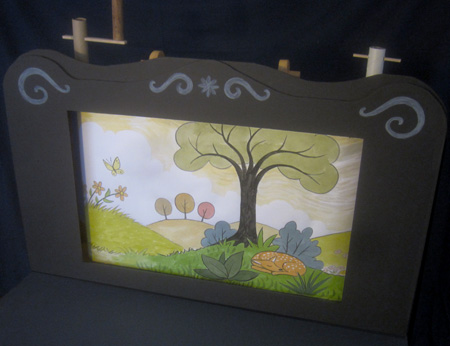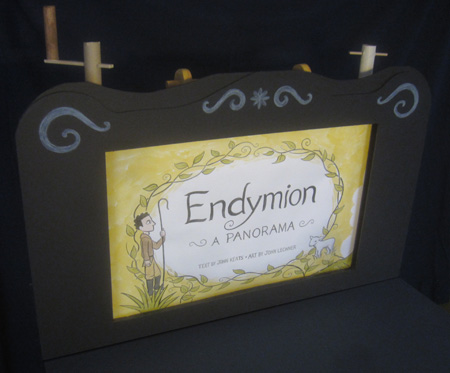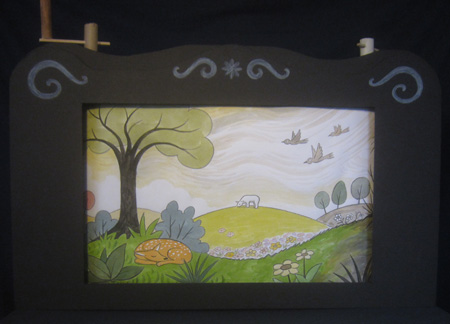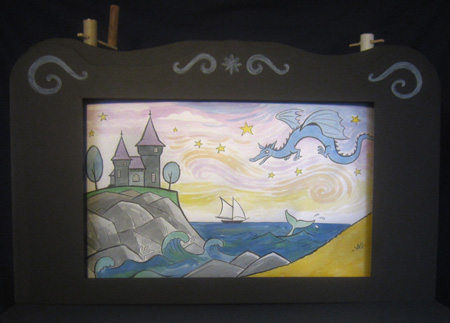
I’ve long had an interest in puppetry, and lately I’ve been experimenting with a related form of theatrical storytelling – the moving panorama, or “crankie.” In this kind of performance, the storyteller turns a crank to reveal a scrolling image, accompanied by a story or song. It’s an old form of theater, and it’s making a quiet comeback in today’s high-tech world.
The appeal of the crankie is hard to pin down, it is deceptively simple on the surface. And yet when the scrolling images are revealed in front of an audience, there is a kind of breathless anticipation of what’s coming next. The forward motion of the images and the forward motion of the story or music create something very magical and unique.
There is a great small theater in the Boston area called Puppet Showplace Theater, and they often host evening cabaret shows for adults called puppet slams. Each puppet slam is a variety of short acts, sometimes experimental, often funny, always unpredictable. It’s a great place to push the boundaries of the art form, as artists have employed video, object theater, and animation at these events. For the past two years I have created and performed crankie stories at the fall “fairy tale” puppet slam. This year I wanted to try another. And rather than use an original story as in the past, I decided to adapt and illustrate a classic poem by Keats, the opening stanza to his epic Endymion.
Why this particular poem? I wanted something lyrical, short, in the public domain, with allusions to myth or fairy tale, from an author with whom I felt a connection. The opening stanza of Endymion, an epic poem inspired by a Greek legend, fit all the requirements. It was open-ended enough for me to experiment with, and short enough to complete in the three weeks before the event.

A scrolling panorama falls somewhere between a comic and an animated film — the images are still, but they move (sort of) as they scroll past the frame. The goal is to make the images flow easily from one scene to the next, and use the reveal of the scroll to increase the drama, much as you would use the page-turn in a picture book. The way images move across the opening is part of the magic. I started the project with small storyboards, to see if the basic concept would work. Then I did two more sets of storyboards, refining each one.
Then I began sketching on a large scroll of paper, eighteen inches high and thirty feet long. (I used almost the entire length.) At each stage, I revised and revised, especially the final big scroll. After finishing the pencil drawing, I painted over the lines with waterproof ink and a brush.

Then I painted over that with watercolors. Since watercolor paper is too heavy and stiff to roll up into a scroll, I used drawing paper (100 lb), and the painting was not always easy. Colors often dulled, and the paper often buckled, though rolling up the paper helped straighten things out. I had to simplify my art style, both for the physical medium and also to make the images clear for the audience.

 As I rehearsed the poem with the images, I decided that music would help tie everything together. I recorded myself playing the ukulele, and tried out different ideas until I had something that matched the piece, and recorded it. Finally it was all finished, I fit the big scroll into the crankie stage (built by my sister Nancy) and was ready to go.
As I rehearsed the poem with the images, I decided that music would help tie everything together. I recorded myself playing the ukulele, and tried out different ideas until I had something that matched the piece, and recorded it. Finally it was all finished, I fit the big scroll into the crankie stage (built by my sister Nancy) and was ready to go.
It was a challenging project in many ways — interpreting a classic text, using one continuous image, making the images bold and clear for an audience, getting it done in time. But it was all very rewarding. I performed the final work at Puppet Showplace Theater for their puppet slam in October, reciting the poem while turning the images, as the music played in the background.

Performing it for a live audience is perhaps the most magical part of the whole experience. As an author, I’ve done many book readings where I’ve held up my book to show the pictures, but books aren’t really designed for this kind of experience. Even when a book is projected onto a screen, it’s not the same as holding it in your lap, and seeing the pictures close up. But a scrolling crankie is designed for a live audience, and the medium has great potential for dramatic effect.
Here are some photos of the final images. You can learn more about crankies over at The Crankie Factory website.






Beautifully done, John! I love the name crankie!
Can’t wait to see it sometime. I want to make my own to use in my teaching!
Your work is beautiful, John! I love crankies–and wish I could see this one in performance. Thank you for sharing the whole process–it’s really wonderful to see your work unfold.